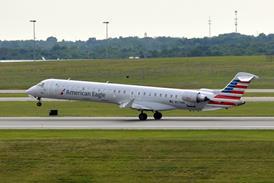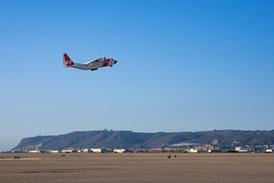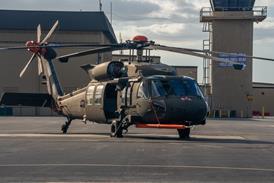GRAHAM WARWICK / WASHINGTON DC
As manufacturers come to recognise high speed as a selling point, building a supersonic business jet is becoming a serious prospect
For the busy executive, time is money - and business jets have come to be regarded as time-saving tools. But while manufacturers have steadily introduced larger cabins and longer range, they have only recently begun to recognise higher speed as a selling point. The trend is encouraging those who have long wanted to develop a supersonic business jet (SSBJ).
"There is a market for a smaller supersonic aircraft," says Gulfstream senior vice-president, programmes, Pres Henne. "It's a market that's waiting for us if we can do it," he adds. The obstacles to an SSBJ remain enormous, but as businesses become more global and time becomes even more valuable, many believe the supersonic business jet will become a reality. "The schedule we're looking at is a 2010-2012 entry into service," Henne says.
That speed sells has been demonstrated clearly by Cessna, which has confounded critics by securing a steady market for the Citation X. The aircraft cruises at Mach 0.92, and is the fastest US civil aircraft. Despite competition from newer business jets, offering larger cabins and longer range at lower prices, the Citation X remains popular precisely because of its speed advantage over rival aircraft.
First flown in 1993, and the flagship of Cessna's business jet range, the Citation X is an embodiment of NASA's transonic research in the 1970s and 1980s. The sleekly swept and slender supercritical wing, and dramatically area-ruled fuselage were designed to delay drag rise and allow the aircraft to cruise at Mach 0.9. After flight testing, in which the Citation X routinely reached M0.99 in a dive, the maximum operating Mach number was raised to M0.92.
Higher cruise speeds
Even on the US transcontinental missions for which the Citation X was designed, its higher cruise speeds can translate into flight times up to an hour shorter than some of its rivals - Los Angeles to New York in just over 4h, and back in just under 5h, for example. The Citation X's speed advantage has proved popular in the US fractional ownership market. While no manufacturer has followed Cessna's lead by designing an aircraft dedicated to going fast, others agree that speed is increasingly important to customers. Both Bombardier and Gulfstream report that operators of their respective ultra-long-range business jets, the Global Express and Gulfstream V, frequently trade range for speed. Both aircraft were designed to fly at least 12,000km (6,500nm) at M0.8, but offer respectable ranges at higher speeds. The improved GV-SP will fly almost 12,500km at M0.8, but still offers 9,250km range at its M0.87 maximum speed.
The need for speed is already influencing the design of new business jets. Before deciding to base its new super-large business jet, the Global 5000, on the Global Express, Bombardier considered using the comparably sized CRJ700 regional jet as the basis. But the CRJ airframe did not offer the combination of high-cruise speed and short-field performance the company wanted. Using the Global Express's 35í-swept, high-lift wing, the Global 5000 is designed to fly 8,900km at M0.85. At its M0.88 maximum speed, the aircraft will still fly 6,850km - enabling it to reach Chicago from Paris, for example, more than an hour quicker than the rival Dassault Falcon 900EX, which cruises at M0.8.
Dassault has recognised the desire for more speed with its latest business jet, the Falcon 7X. This aircraft features a new, more swept and slender "high-transonic" wing, giving the aircraft a maximum operating Mach number of 0.9. Although the 7X's design range is 19,400km at M0.8, the French manufacturer acknowledges that operators will conduct most flights at M0.85 and above.
At one time Dassault was leading the charge towards an SSBJ, unveiling its concept for a supersonic Falcon in 1998, but the company's focus has shifted to developing a new family of aircraft around the 7X's high-transonic wing. The manufacturer is continuing supersonic design studies, working with engine manufacturers as well as potential US partners on what it expects will be an international programme.
Gulfstream, meanwhile, has moved to the fore - but also believes that any SSBJ will have to be a joint programme involving more than one manufacturer. The US company has a long association with SSBJs, having begun design work in 1988. Gulfstream teamed with Sukhoi in 1989, with the intention that the Russians design and build the airframe, but the relationship foundered. Sukhoi continues to seek backers for its S-21 SSBJ today. Gulfstream, meanwhile, shelved the project only to resurrect it in 1998 when the company teamed with Lockheed Martin to study the feasibility of an SSBJ.
This relationship was also to prove short-lived, but while they were working together the companies spurred into existence the US Defense Advanced Research Projects Agency's Quiet Supersonic Platform (QSP) programme. Started last year, this is a two-year, $35-million effort to develop and validate technologies that would reduce sonic boom and make unrestricted supersonic flight over land possible - the key requirement for a successful SSBJ. QSP is looking at technology applicable to both military aircraft and commercial transports, and manufacturers hope it will lead to an X-plane demonstrator that could form the basis of an SSBJ.
Gulfstream has conducted two assessments of the market for an SSBJ, and identified "conservative" sales of 180-350 aircraft. This compares well with independent forecasts, which have estimated the market at 200-400 aircraft. "That makes it a very typical, traditional Gulfstream programme," says Henne. The market studies showed that supersonic overland flight is "a requirement", and that range beyond 7,400km is "an advantage".
Fractional ownership is viewed as having great potential to increase the SSBJ market, particularly with the $70 million-100 million price tag Gulfstream is expecting the aircraft to carry. "We have a business case that supports this price and that for us as a manufacturer would be profitable. We think the market would value it in that price range," says Henne. "Compare it with $40 million for a GV. If you had said in the early 1990s that people would be standing in line to buy the GV for $40 million, they'd have said you were crazy," he adds.
Gulfstream sees another opportunity for the SSBJ - scheduled service, particularly with airlines looking for ways to hold on to their premium passengers. The company calculates that airlines could operate a 14-passenger SSBJ profitably, charging $9,000 for a New York-London roundtrip, compared with $11,000 for a first-class ticket on a Boeing 777. The flight would also be markedly shorter. Other potential markets include commercial small-parcel services as well as military logistics transport and special missions.
Source: Flight International























